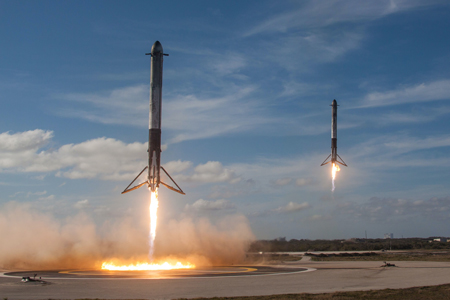SpaceX has had some impressive highs and lows. Founded in 2002, the private space company has become a major participant in rocket launches and has helped achieve Elon Musk, the founder and CEO, achieve its goal of repurposing space travel to the United States after the program was terminated.
Here”s a breakdown of some of SpaceX”s most significant rocket launches, landings, payloads, and tests to date, as well as a look at what”s in store for future launches that will bring humans to the Moon, Mars, and beyond.
1.THE FIRST SUCCESSFUL FLIGHT OF FALCON 1
The first launch of its first rocket, the Falcon 1, was delayed for one minute. Despite Musk”s assertion, spaceX was in desperate need of bankruptcy. The funds for the fourth attempt were “the last sum we had.”
According to SpaceX, the Falcon 1successfully reached orbit on its fourth launch attempt on September 28, 2008. It is “the first privately developed liquid-fuel rocket to reach Earth.”
The Falcon 1 vehicle was launched five times. After the successful Falcon 1 launch, SpaceX initially planned to develop a more refined version of the Falcon 1 called the “Falcon 1e,” but that plan was dismissed in favor of the Falcon 9.
2.THE DRAGON SPACECRAFT RETURNS TO EARTH
The Dragon spacecraft from SpaceX is a capsule designed to transport astronauts and supplies to the International Space Station (ISS). In 2010, SpaceX launched Dragon into orbit aboard Falcon 1”s successor, the Falcon 9 launch vehicle.
When the unmanned Dragon returned to Earth in December 2010, it landed in the Pacific Ocean a few hundred miles off the coast of Mexico. It was the first time a private spacecraft successfully returned from orbit.
3.THE DRAGON DOCKS ON THE ISS
SpaceX was the first private company to dock with the International Space Station for another incredible achievement.
SpaceX sent Dragon to the ISS on May 25, 2012. After that mission, astronauts used a robotic arm to pull the Dragon capsule into a docking port at the station. Since then, SpaceX has sent Dragon to the ISS several times on resupply missions for NASA.
THE FIRST ROCKET BOOSTER LANDING IN SPACEX HAS FORGED A NEW LEASE.
Elon Musk established SpaceX as a spacecraft and acquiring the ability to land and reuse objects. At the time, Elon Musk realized that the spaceX consensus was that sending humans there would be prohibitively expensive as a result of the current technology. Elon Musk decided to expand the aerospace industry.
One of the major improvements required was the ability to reuse large parts of a spacecraft that would otherwise collapse in orbit. In 2015, SpaceX achieved this feat with its historic first unmanned upright landing with a Falcon 9 rocket booster.
5.THE FIRST DRONE SHIP LANDING
In 2016, SpaceX began to make things simple. Almost a year after its first successful vertical landing, the company landed its spacecraft on a small platform floating in the ocean. After several failure attempts, the company achieved its first successful landing of a rocket booster on a drone ship called Just Read the Instructions.
While some commentators have suggested that SpaceX lands the majority of its ocean missions because it is more cost-effective than landing on land, Elon Musk revealed in a series of tweets in 2016 that it”s “all about speed” and the fact that the boosters must climb in an arc-like trajectory to reach orbital space.
6.SPACEX IS THE FIRST COMPANY TO USE A ROCKET.
When it comes to reusability and reducing space travel, landing a rocket is only a part of the equation. As SpaceX successfully demonstrated in 2017, it is possible to reuse one of NASA”s previously used space shuttles and solid rocket boosters (which were landed in the sea, were recovered by ship, and repaired).
On March 30, 2017, SpaceX relaunched its Falcon 9 rocket with a satellite onboard and successfully recovered it once more by landing it on a drone ship in the Atlantic Ocean.
7.THE DRAGON CAPSULE IS REUSABLE TOO
After proving that it could reuse its rockets, SpaceX proved that it was also able to reuse its Dragon capsule. On June 3, 2017, the company launched a Falcon 9 rocket with a previously used Dragon capsule on board.
It was SpaceX”s 11th mission to deliver supplies to the ISS. The Dragon capsule that was reused had originally been used in the fourth ISS mission. It is considered a great step toward making the journey to Mars possible.
8.THE FIRST PRIVATELY FUNDED LUNAR MISSION IN HISTORY
In February 2019, SpaceX celebrated the incredible return of its rocket booster. What made this mission so real was the fact that the Falcon 9, as part of the Nusantara Satu mission, included a privately-funded Israeli robotic moon lander called Beresheet as a secondary payload.
Beresheet failed to land on the moon very easily, although the Israeli company that owned the lander has said that it would stop landing on the moon mission.
9.THE FALCON HEAVY TAKES OFF AND SENDS A TESLA INTO SPACE.
The Falcon Heavy, the successor of Falcon 9, was first launched in 2018, with 27 engines, and it was the most powerful rocket to have landed in the United States since the Saturn V from NASA”s Apollo peak.
SpaceX had used a pair of recycled boosters to send a huge payload to space. Only eight minutes after launch, the same two Falcon Heavy side boosters returned and landed simultaneously at adjacent landing pads at Cape Canaveral.
If that wasn”t sufficient, this launch would be the birth of a “star”: SpaceX and Tesla”s “Starman.”
THE 10. COMMERCIAL FLIGHT LAUNCH OF FALCON HEAVY HAS SET NEW RECORDS.
With its commercial satellite launch flights, Falcon Heavy has grown a significant player. The rocket is capable of carrying an impressive141,000 pounds (64 tonnes) into orbit, which is a lot of Tesla Roadsters.
One example of a recent successful Falcon Heavy project is the launch of the Arabsat-6A satellite last year, in which SpaceX surpassed its own record fordistance during booster recovery with a maneuver that saw it re-enter the Earth”s atmosphere and travel about 770 miles (1240 km).
11.THE FIRST BATCH OF STARLINK INTERNET SATELLITES HAVE REACHED ORBIT.
On May 23, 2019, atop a Falcon 9, SpaceX has sent more than 2,600 Starlink satellites into orbit, and more than 1,600 of them are currently operational.
Following Russia”s invasion of the country, the service was praised for providing protection for Ukrainian civilians and soldiers, although NASA has also warned that the satellites may reduce its capability to detect a potentially hazardous asteroid.
12.STARHOPPER””S FIRST UNTETHERED FLIGHT
Starhopper is SpaceX”s MK1 prototype for Starship, a rocket that Musk hopes to eventually bring humans to Mars.
SpaceX conducted “hops” with Starhopper to test the enormous power of Starship”s Raptor engines in flight. In other words, they have sent the spacecraft into the atmosphere for brief periods without reaching orbit.
On July 26, 2019, Starhopper”s first successful hop sanded 65 feet (20 meters) into the air before coming back down to land. According to Elon Musk, “water towers can fly!”
13.SPACEX””S FIRST ASTRONAUT LAUNCH
The Crew Dragon capsule was completely rescheduled after SpaceX”s first astronaut launch. The entire flight was smooth without a hitch, starting on May 30, 2020, and docking on the ISS just a day later on May 31.
While sailing was smooth, the astronauts, Bob Behnken and Doug Hurleydid say that riding a Falcon 9 was “totally different” to riding NASA”s Space Shuttle, and that the experience was somewhat rougher than expected.
After this, the newly-named ”Endeavour” Demo-2 capsule returned to Earth on August 2, 2020, with the astronauts on board.
14.SN5 STARSHIP PROTOTYPE SOARS
After ”Starhopper”s second test flight, the company “hope” its 500-foot prototype, prompting further testing, including a few less successful ones, on August 4, 2020.
At its Boca Chica development facility, SpaceX surpassed 500 feet (150 meters) with the “hop” of its SN5 Starship prototype. Following a successful test, in which SN5 took off before making an incredible smooth landing, Elon Musk said, “Mars is looking real.”
Elon Musk said that the final design of the SN5 Starship prototype will include about 41 Raptor engines.
15.SPACEX”S 100TH LAUNCH AND SIXTH TIME REUSING THE SAME FALCON 9 BOOSTER
With one launch, SpaceX reached two impressive milestones on August 18, 2020. It was also the 100th launch in the company”s history.
Moreover, the mission was the sixth time that SpaceX reused the Falcon 9 boosterB1049. That”s a new record for the most times SpaceX or any company for that matter has reused a commercial rocket to date. This is a real testament to SpaceX”s commitment to rocket reusability.
THE FIRST FULLY OPERATIONAL FLIGHT OF CREW DRAGON
On November 15, 2020, the Crew Dragon, which can be adjusted to carry up to seven astronauts, sent four people to ISS on its first fully operational mission, Crew-1. This was the first NASA-certified commercial human spacecraft system in history. As a result of the massive confidence vote, NASA assigned astronauts for Crew-1 before the Demo-2 test mission had even occurred.
Soichi Noguchi, a Japanese astronaut, and NASA astronauts, including Michael Hopkins, and Victor Glover, went on the Crew-1 mission.
THE ”BELLY FLOP” MANEUVER FOR THE STARSHIP PROTOTYPE WAS 17 YEARS OLD.
The Starship SN8 from SpaceX landed at an altitude of roughly 41,000 feet (12.5 km) on December 9, 2020. Just before the explosion, the Starship prototype performed an amazing mid-air flip maneuver.
After SN8, last year”s SN15, nailed its landing while carrying out the flip maneuver. A glimpse into the finalized Starship launch vehicle.
18.CREW-2 ASTRONAUTS HEAD TO THE ISS
On April 23, 2021, a Crew Dragon spacecraft carrying NASA”s SpaceX Crew-2 astronauts manned a Falcon 9 rocket. This was the second commercial crew rotation mission aboard the ISS.
Crew of astronauts was headed for NASA alongside NASA astronauts Shane KimbroughandMegan McArthur and NASA astronautAkihikoHoshideand, an ESA astronaut. The group spent six months on the ISS and flew over an impressive Aurora Borealis before a crash.
THE FIRST ALL-PRIVATE CREW TO BE LAUNCHED FOR INSPIRATION4 IS THE FIRST ON EARTH.
On September 15, 2021, a SpaceX Falcon 9 rocket built a Crew Dragon spacecraft on the first all-private, all-civil orbital mission. The mission, known as Inspiration4, was privately operated by billionaire Jared Isaacman and raised money for St. Jude”s Research Hospital.
Isaacman”s team included Sian Proctor, a geoscientist and science communication specialist, and Hayley Arceneaux, a data engineer. The crew lasted three days.
As customers travel to suborbital space for less than 30 minutes, the mission was seen as a smashing success and a significant leap for space tourism.
20: CREW-3 AND 4 ALSO FLEW TO THE ISS
Crew-3 was launched on November 11, 2021, with the 600th astronaut to enter space since human spaceflight began. Russia conducted a missile test that sent debris through orbit. Later, the Crew-3 astronauts stated they were not “scared” of a possible impact, although they must accommodate in aSpaceX Crew Dragonspacecraft as a precaution.
The Crew-4 mission was lifted off on April 27, 2022, launching Jessica Watkins, the first African American woman to take over on a long-duration flight aboard the ISS, and Samantha Cristoforetti, the first European woman to take over the ISS. Crew-4 was SpaceX”s longest flight, clocking in at 15 hours and 45 minutes.
AX-1: SPACEX UNDERTAKES ITS FIRST PRIVATE MISSION TO THE INTERNATIONAL SPACE STATION.
The first all-private mission to the ISS, Ax-1, was launched atop a Falcon 9 on April 8, 2022. Axiom Space, a Texas startup, was able to conduct a 17-day mission and is developing a private orbital space station.
Ax-1 was not the first time civilians went to the International Space Station. Roscosmos, Russia”s space agency, has also launched non-astronauts to the space station aboard their Soyuz launch vehicle. However, those were trained by volunteers. He is now working as a civilian pilot for Axiom Space.
22.STARSHIP”S NEXT ORBITAL MAIDEN FLIGHT
Two launch date estimates for Starship”s orbital maiden flight have broken since this article was first published in August 2020. In 2019,SpaceX CEO Jonathan Hofeller gave an update on the Starship project, claiming it might be orbital by 2020.
Musk announced in March that Starship might begin orbiting, but the FAA delayed the review of Starship, but SpaceX president Gwynne Shotwell has recently announced that the launch would now take place in June or July.
As SpaceX is waiting for the FAA approval, the launch will most likely take place this summer, thus we aren”t far away from seeing the first orbital flight from a spacecraft that might eventually take humans to Mars.
In 2019 and 2020, the first prototypes of Starship completed low-velocity flight tests of vertical launches and landings.
23: ANNOUNCING A NEW MISSION IN THE POLARIS PROGRAM WILL INCLUDE STARSHIP”S FIRST CREWED SPACEFLIGHT.
The Polaris Dawn program is a series of exercises led by Jared Isaacman, the billionaire who spearheaded the Inspiration4 project. The first mission, Polaris Dawn, is to construct the first all-private spacewalk, which is also intended to achieve the highest Earth orbit ever created, surpassing the current record of 853 miles above Earth.
Isaacman has also announced that he has agreed to fund three additional spaceflight missions in connection with a privately funded space program with SpaceX. The third of these flights will be the Starship”s first crewed flight, thus Starship”s first crewed flight will not be contracted by NASA.
24: AWAY FROM THE STARSHIP MOON
Starship was chosen by NASA in April 2021 to land humans back on the Moon. The private space business was awarded a $2.9 billion contract, defeating Jeff Bezos” Blue Origin to the punch, and leading to a horrifying lawsuit that Blue Origin ultimately lost.
Starship will be fully reusable and greatly reduce the cost of subsequent flights, which is why NASA decided to use it for its Artemis III mission, the first Moon landing since 1972. By contrast, Artemis I and II will launch aboard the space agency”s new Space Launch System (SLS). Artemis III is currently scheduled for 2025.
25.THE FUTURE OF SPACEX: MARS AND BEYOND?
Elon Musk described it shortly after Falcon 9”s first successful landing, and getting humans to Mars would be “the most incredible adventure ever.” From the moment he founded SpaceX, there”s little doubt that he had set his sights on reaching the Red Planet.
While there is still no date in stone for SpaceX to arrive on Mars, experts are already looking at ideal locations for landing on the Red Planet. According to Paul Wooster, SpaceX”s primary Mars development engineer, recently stated that the company is on track toreach Mars within the 2020s.
The game is on: Project Artemis and Jeff Bezos” Blue Origin partnership are just two examples of other space programs that benefit the public”s rekindled fascination for space travel and which have also set their sights beyond Earth”s stratosphere.
If SpaceX does eventually reach Mars, it will be the company”s most significant achievement yet, and that”s all there is going to be.
Note 13/05/22: This article has been updated as part of some of SpaceX”s most recent notable achievements.



























